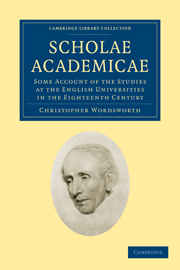 Scholae Academicae
Scholae Academicae Book contents
- Frontmatter
- PREFACE
- Contents
- CHAPTER I GENERAL INTRODUCTION
- CHAPTER II THE TRIPOS, name and thing
- CHAPTER III THE SOPHS' SCHOOLS before 1765
- CHAPTER IV ACTS AND OPPONENCIES after 1772
- CHAPTER V THE SENATE-HOUSE
- CHAPTER VI THE ADMISSION OF QUESTIONISTS. Huddling
- CHAPTER VII THE MATHEMATICKS
- CHAPTER VIII THE TRIVIAL ARTS
- CHAPTER IX HUMANITY
- CHAPTER X MORALS AND CASUISTRY
- CHAPTER XI LAW
- CHAPTER XII MODERN STUDIES
- CHAPTER XIII ORIENTAL STUDIES
- CHAPTER XIV PHYSICK
- CHAPTER XV ANATOMY
- CHAPTER XVI CHEMISTRY
- CHAPTER XVII GEOLOGY AND MINERALOGY
- CHAPTER XVIII BOTANY
- CHAPTER XIX The Degree of M.A.
- CHAPTER XX MUSICK
- CHAPTER XXI ASTRONOMY
- CHAPTER XXII CONCLUSION
- APPENDICES
- INDEX
CHAPTER XV - ANATOMY
Published online by Cambridge University Press: 07 September 2010
- Frontmatter
- PREFACE
- Contents
- CHAPTER I GENERAL INTRODUCTION
- CHAPTER II THE TRIPOS, name and thing
- CHAPTER III THE SOPHS' SCHOOLS before 1765
- CHAPTER IV ACTS AND OPPONENCIES after 1772
- CHAPTER V THE SENATE-HOUSE
- CHAPTER VI THE ADMISSION OF QUESTIONISTS. Huddling
- CHAPTER VII THE MATHEMATICKS
- CHAPTER VIII THE TRIVIAL ARTS
- CHAPTER IX HUMANITY
- CHAPTER X MORALS AND CASUISTRY
- CHAPTER XI LAW
- CHAPTER XII MODERN STUDIES
- CHAPTER XIII ORIENTAL STUDIES
- CHAPTER XIV PHYSICK
- CHAPTER XV ANATOMY
- CHAPTER XVI CHEMISTRY
- CHAPTER XVII GEOLOGY AND MINERALOGY
- CHAPTER XVIII BOTANY
- CHAPTER XIX The Degree of M.A.
- CHAPTER XX MUSICK
- CHAPTER XXI ASTRONOMY
- CHAPTER XXII CONCLUSION
- APPENDICES
- INDEX
Summary
“Quando enim, obsecro, a conditâ Academiâ in tot canum, piscium, volucrumque neces ac lanienas sangumolenta curiositas saeviit, quo vobis partium constitutio et usus in animalibus innotesceret? O innocentissimam crudehtatem et feritatem facile excusandam!”
I. Barrow, In Comitiis. [1654.]Dissection appears to have been no modern innovation at Cambridge, for queen Elizabeth granted two bodies for anatomical purposes to the medical students of Gonville and Caius. By a grace of Nov. 27, 1646, the three dissections required by the University Statutes (capp. 15, 17) as a qualification for M.D., and the two required from students aspiring to M.B., were revived, this exercise having fallen into disuse. Five years later ‘vividissections of dogs and such-like creatures’ were popular.
James Keill (younger brother of John Keill the Newtonian, see in the index), 1673—1719, having studied medicine at Edinburgh and Leyden, read anatomical lectures at Oxford, and also at Cambridge, where he also took the degree of M.D. in 1705.
In 1723 Parliament considered and rejected a clause facilitating the acquisition of the corpses of felons of Cambs. and Hunts, for dissection by the Cambridge faculty.
In the spring of 1732, when John Morgan of Trinity (B.A. 1721) was professor of Anatomy, a body was dug up in a village near Cambridge, and carried to Emmanuel College. A riot arose, and a warrant was issued to search the College, but in vain.
- Type
- Chapter
- Information
- Scholae AcademicaeSome Account of the Studies at the English Universities in the Eighteenth Century, pp. 182 - 186Publisher: Cambridge University PressPrint publication year: 2009First published in: 1877
